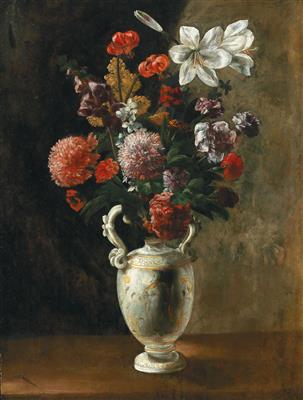Giovanni Martinelli

(Montevarchi 1600/4–1659 Florence)
Roses, foxgloves, peonies, carnations and lilies, in a majolica vase,
oil on panel, 68.5 x 52 cm, framed
Provenance:
Private European collection;
where acquired by the present owner
We are grateful to Francesca Baldassari and Daniele Benati for both independently confirming the attribution of the present painting.
The present painting can be considered among the first flower paintings of its type created in Florence during the 1630s or 1640s. Jacopo Ligozzi´s extraordinary scientific illustrations and the works on parchment by the miniaturist Giovanna Garzoni display the interest in depicting nature in Florentine painting. Indeed, the compositional choice of placing the multi-coloured flowers at the centre of the table in a simply decorated majolica vase displays the influence of the flower paintings by Jacopo Ligozzi with whom Martinelli studied. This type of compositional solution was also used in Rome in the early years of the seventeenth century by followers of Caravaggio.
The present painting reveals the artist’s sensitivity to the chromatic harmonies ranging from the off whites through to the vermillion reds of the flowers and from the dark background tones through to the deep green of the leaves. A similar pictorial quality can be found in other still life paintings by Martinelli on the basis of comparisons with the floral passages depicted his altarpieces. Indeed, the present painting can also be compared to the Still life with roses, asparagus, peonies and carnations in the Palazzo Pitti, Florence (inv. 1890, no. 6688), datable to the late 1640s, which although more compositionally complex reveals roses rendered in a very similar manner to those in the present work. Moreover, the transversal lighting illuminating the table from the right, has counterparts in the Saint Agatha visited in prison by Saint Peter (Cassa di Risparmio di Pistoia e Pescia collection) and the Madonna of the Rosary and Saints in the church of San Michele Arcangelo in Biforco (1647), where in the foreground roses and lilies are similar to those in the present painting. In the Belshazzar’s Feast in the Uffizi (1653) a singularly idiosyncratic type of theatrical lighting is deployed which intermingles with the palette.
Martinelli was from Montevarchi but lived from 1623 to 1625 with his master Jacopo Ligozzi in Florence. Subsequently, he probably went to Rome as his interest in naturalism and dramatic lighting effects would suggest, and this interest is evident in his first dated work, the Miracle of the Mule in the church of San Francesco in Pescia (1632). A succession of paintings dating to the 1630s and 1640s reveal the painter’s connections with the faction of the French followers of Caravaggio, and most notably to Valentin de Boulogne and Simon Vouet.
30.04.2019 - 17:00
- Estimate:
-
EUR 40,000.- to EUR 60,000.-
Giovanni Martinelli
(Montevarchi 1600/4–1659 Florence)
Roses, foxgloves, peonies, carnations and lilies, in a majolica vase,
oil on panel, 68.5 x 52 cm, framed
Provenance:
Private European collection;
where acquired by the present owner
We are grateful to Francesca Baldassari and Daniele Benati for both independently confirming the attribution of the present painting.
The present painting can be considered among the first flower paintings of its type created in Florence during the 1630s or 1640s. Jacopo Ligozzi´s extraordinary scientific illustrations and the works on parchment by the miniaturist Giovanna Garzoni display the interest in depicting nature in Florentine painting. Indeed, the compositional choice of placing the multi-coloured flowers at the centre of the table in a simply decorated majolica vase displays the influence of the flower paintings by Jacopo Ligozzi with whom Martinelli studied. This type of compositional solution was also used in Rome in the early years of the seventeenth century by followers of Caravaggio.
The present painting reveals the artist’s sensitivity to the chromatic harmonies ranging from the off whites through to the vermillion reds of the flowers and from the dark background tones through to the deep green of the leaves. A similar pictorial quality can be found in other still life paintings by Martinelli on the basis of comparisons with the floral passages depicted his altarpieces. Indeed, the present painting can also be compared to the Still life with roses, asparagus, peonies and carnations in the Palazzo Pitti, Florence (inv. 1890, no. 6688), datable to the late 1640s, which although more compositionally complex reveals roses rendered in a very similar manner to those in the present work. Moreover, the transversal lighting illuminating the table from the right, has counterparts in the Saint Agatha visited in prison by Saint Peter (Cassa di Risparmio di Pistoia e Pescia collection) and the Madonna of the Rosary and Saints in the church of San Michele Arcangelo in Biforco (1647), where in the foreground roses and lilies are similar to those in the present painting. In the Belshazzar’s Feast in the Uffizi (1653) a singularly idiosyncratic type of theatrical lighting is deployed which intermingles with the palette.
Martinelli was from Montevarchi but lived from 1623 to 1625 with his master Jacopo Ligozzi in Florence. Subsequently, he probably went to Rome as his interest in naturalism and dramatic lighting effects would suggest, and this interest is evident in his first dated work, the Miracle of the Mule in the church of San Francesco in Pescia (1632). A succession of paintings dating to the 1630s and 1640s reveal the painter’s connections with the faction of the French followers of Caravaggio, and most notably to Valentin de Boulogne and Simon Vouet.
|
Buyers hotline
Mon.-Fri.: 10.00am - 5.00pm
old.masters@dorotheum.at +43 1 515 60 403 |
| Auction: | Old Master Paintings |
| Auction type: | Saleroom auction |
| Date: | 30.04.2019 - 17:00 |
| Location: | Vienna | Palais Dorotheum |
| Exhibition: | 20.04. - 30.04.2019 |
